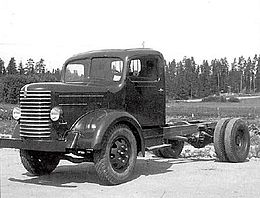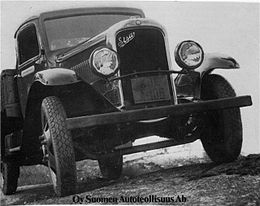Gate Nessling
Tor Ragnar Nessling , Vuorineuvos (born September 6, 1901 in Helsinki , Grand Duchy of Finland , † November 23, 1971 in Helsinki, Finland ) was a Finnish engineer and leading industrialist. For almost four decades he was the general manager of the Finnish truck manufacturer Suomen Autoteollisuus (SAT).
Nessling became head of SAT in 1932, soon after the company was founded. He developed the company at a time when few believed in the possibility of a Finnish automotive industry and a decade later he became the majority shareholder in SAT. Nessling patriarchally managed the company in which trucks, bus chassis, rail vehicles and terminal tractors were built. He lost his controlling stake after a merger in 1968. He resigned in 1970 and died the following year.
Studies and Early Career
Tor Nessling's parents were engineer John Nessling and Greta geb. Grönholm. In 1920 Nessling passed his Abitur at the Helsinki coeducational high school Läroverket för gossar och flickor . He continued his studies at the Faculty of Mechanical Engineering at Helsinki University of Technology. At the same time he studied geology at the University of Helsinki from 1922-24. Nessling graduated as a graduate engineer in 1924. He traveled to Sweden, Great Britain, Germany and the USA. Between 1926 and 1928 Nessling worked for the three Finnish automobile importers Korpivaara & Halla , Henry-Auto and Auto-Bil . In 1928 and 1929 he worked as a director at the vehicle stores Munkkisaaren Autotalli ja Konepaja and then between 1929 and 1930 at Autovarikko .
Foundation of the Suomen Autoteollisuus
In 1929 Nessling was appointed technical manager of the bus and body manufacturer Autoteollisuus-Bilindustri. Nessling wanted to develop a new industry for his country and in the same year saw the possibility of entering into truck and bus production for Finland. In 1931 Autoteollisuus-Bilindustri merged with the coachbuilder Osakeyhtiö Autokoritehdas. The name of the new company was Suomen Autoteollisuus ("Finnish Vehicle Industry ") and its first general manager was John Hellsten. It is often claimed that Nessling founded SAT, which is not true. The merger was organized by Karl Arthur Nordgren, Emil Anton Winckelmann and Lars Wilhelm Åberg. However, one year after the company was founded, Nessling was appointed CEO of SAT.
Starting a vehicle production practically from nowhere, in the middle of the global economic crisis, seemed almost impossible, but succeeded under the determined leadership of Nessling. Sisu was chosen as the brand name and the first 12 Sisu vehicles rolled out of the factory in 1932. Although the proportion of domestic components was only 20% at the beginning, Nessling was determined to increase this proportion significantly. He became famous with the sentence: "A Finn can do everything a foreigner can". By the late 1930s, the proportion of domestic components had increased to 40%. Nessling tried to convince the Finnish government of the potential of the automotive industry. He emphasized the employment potential and also the strategic importance of Finnish-controlled vehicle production for national defense. The government ignored his arguments and gradually reduced import duties on heavy-duty vehicles during the 1930s, so that competition became tougher. The owners of SAT also began to doubt the possibilities of domestic truck production. In 1938 Nessling Helsingin Osakepankki offered to buy their shares in SAT, which he was able to acquire relatively cheaply. He had to pledge his wife's property to finance it, but in the end he owned 80% of SAT.
The Second World War and Yhteissisu

The Second World War brought new challenges for SAT as many foreign components became inaccessible. With great efforts, however, the proportion of domestic components could be increased to 90%. A big step was made with the production of the American Hercules engine under license. The main customers for SAT during the war were the Finnish armed forces and other state institutions. Since the production in Helsinki was susceptible to Soviet air raids, the construction of a new factory in Karis began. The production capacity was not sufficient to meet the demand. In 1942 the armed forces estimated that they would need about 7,000 trucks and buses over the next few years. Nesling suggested building the new factory larger than originally planned. However, SAT's economic and technical resources were limited and influential importers of heavy trucks, supported by some political parties, suspected that SAT wanted to use the war to gain a dominant position in Finland. The state proposed partially state ownership of SAT, which Nessling ruled out. The second option proposed was the creation of a new company involving the Finnish state and major Finnish companies, which in 1943 became Yhteissisu , of which Tor Nessling became director general, albeit reluctantly. Yhteissisu began to build Sisu trucks in Vanaja, near Hämeenlinna about 100 km north of Helsinki. The end of the Second World War came before Yhteissisu could fully start producing military trucks. Nessling left his post at Yhteissisu in 1946. The reason for his decision was the lack of support from the company owners. Yhteissisu then used truck production for the civilian market. In 1948 the Yhteissisu company was renamed Vanajan Autotehdas (VAT).
Tor Nessling became increasingly bitter towards the state: first his ideas about the production of heavy trucks were ignored in the 1930s, then the government had forced him to start a new company with technologies that came from Nesling's own company. His dissatisfaction was expressed in the 1960s when the state offered him funding, but he turned it down with the answer: He would never have asked for anything and would never ask the government for anything.
Post War Growth
In the 1950s and 1960s, SAT production grew strongly. During the 1950s, the volume quadrupled to 800 vehicles per year. In addition to the production of trucks and bus chassis, trams and light rail vehicles were also manufactured for the Finnish state railway. The SAT products have been exported to four continents. The growing production volume and investments in the production facilities required that sales had to be promoted through marketing campaigns. Unlike many others, Nessling was open to marketing and concentrated heavily on customizing the trucks, which was very much in line with customer needs. So he invited truck drivers and hauliers to interview them and to test the Sisu trucks to find out what the condition of the trucks should be.
Merger with VAT and retirement
SAT's main competitor, Vanajan Autotehdas (VAT), had financial difficulties in the late 1960s and Nessling proposed a merger between VAT and SAT because he feared a foreign competitor like Volvo or Scania might take over VAT. The merger was then made in 1968. In the end, however, the merger led to a situation that Nessling actually wanted to avoid, as the state became co-owner of the new company with a 17% stake and Nessling's stake fell below 50%. SAT received an executive board of directors and a board of directors. Although Nessling was still the main shareholder of the company, his influence became less and less and he had difficulty getting used to the new situation, as he was talked into his work by the board of directors.
The relationship between Nessling and the board of directors was characterized by tension, whereupon Nessling fell ill. However, he did not recover sufficiently to be able to work as before, although he wanted to continue his role in the company management. The board was not convinced and reorganized the corporate structure. Nessling resisted the transfer of marketing tasks to other hands, but could not prevent it. The old business partner and friend of Nessling, the then head of the British Leyland Motor Corporation , Lord Stokes , whom Nessling held in high regard, advised him to withdraw from the company. Tor Nessling announced his resignation as General Manager of Suomen Autoteollisuus in June 1970 after nearly four decades of running the company. Erik Gillberg was appointed as the new managing director in February 1971.
Personal life and death
Nessling lived a secluded life and avoided the public. He ran his company patriarchally and kept his distance from his subordinates, apart from a few colleagues and friends. Nessling had always worked hard in his life and held his decisions and rule firmly in his own hands. He was considered a brilliant businessman who recognized the company's opportunities, but was also perceived by others to be quick-tempered and excessively risk averse. But he also had soft sides, so he was a great nature lover and kept several pets.
Tor Nessling was born in 1926 with Greta Maria "Maj". Kock, who supported her husband in his career as a housewife. The marriage remained childless. When Tor Nessling died in 1971, his widow sold the family shares on the SAT. In 1972 she contributed her fortune to the Maj ja Tor Nesslingin Säätiö Foundation (Maj and Tor Nessling Foundation). Today the foundation is an important donor of environmental research in Finland.
Awards
- Vuorineuvos (1962)
- Commander of the Lion of Finland
- Freedom Cross, 3rd class
- Freedom Cross, 4th grade
- Knight of the White Rose, 2nd class
- Freedom Medal, 2nd Class
- Commemorative Medal of the Winter Wars
Individual evidence
- ↑ a b c d e f g h i j k l m n o p q Timo Herranen: Biografiakeskus - Vuorineuvos Tor Nessling (1901–1971) ( Finnish ) Suomalaisen Kirjallisuuden Seura. September 5, 2008. Retrieved October 22, 2013.
- ↑ a b c d e f g h Näin syntyi Sisu . In: Oy Suomen Autoteollisuus Ab (Ed.): Sisuviesti . No. 2, 1981, pp. 4-11. Retrieved March 16, 2013.
- ^ Olli Blomberg: Ne "suuret" suomalaiset . In: Höyryvaunusta kymppipyörään ( Finnish ). Tekninen Kustannusliike Oy, 1991, ISBN 951-9364-35-8 , p. 72 (accessed March 16, 2013).
- ↑ a b Blomberg, Olli: Yhteissisusta Vanajan ja Sisun kautta Patriaan . Patria Vehicles Oy, Hämeenlinna 2003, ISBN 952-91-5613-8 , p. 12-41 (Finnish).
Web links
| personal data | |
|---|---|
| SURNAME | Nessling, gate |
| ALTERNATIVE NAMES | Nessling, Tor Ragnar (full name) |
| BRIEF DESCRIPTION | Finnish engineer, industrialist and vuorineuvos |
| DATE OF BIRTH | September 6, 1901 |
| PLACE OF BIRTH | Helsinki , Grand Duchy of Finland |
| DATE OF DEATH | November 23, 1971 |
| Place of death | Helsinki, Finland |
